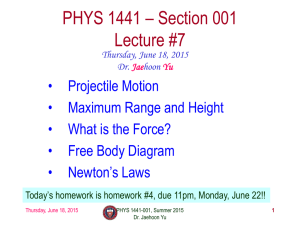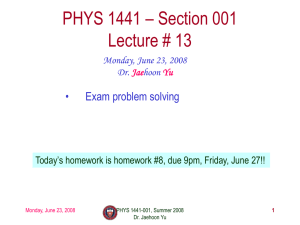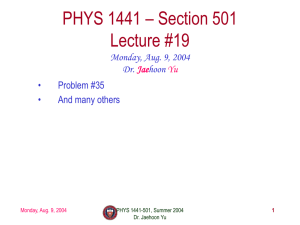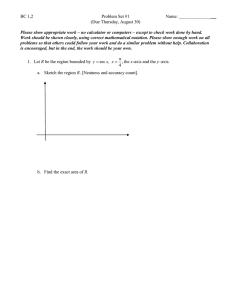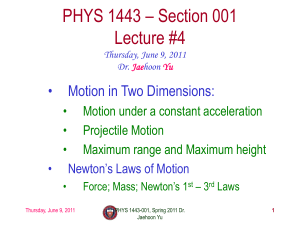Thursday, June 12, 2014
advertisement
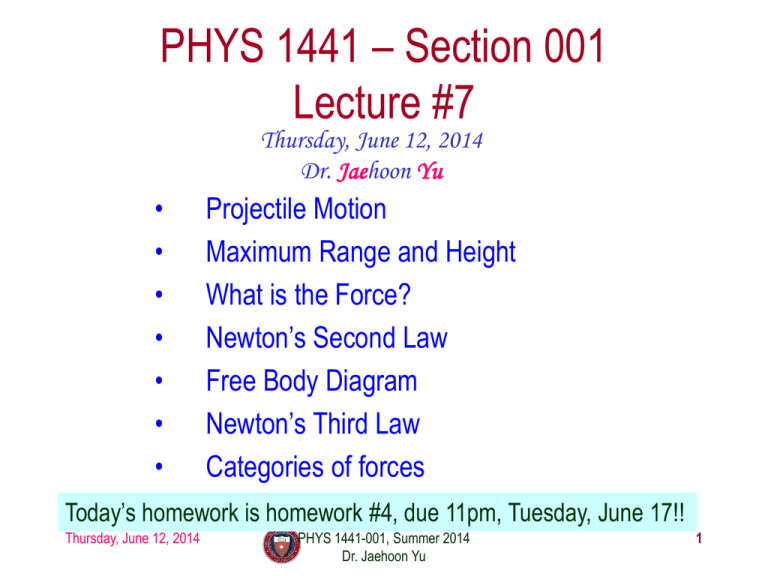
PHYS 1441 – Section 001 Lecture #7 Thursday, June 12, 2014 Dr. Jaehoon Yu • • • • • • • Projectile Motion Maximum Range and Height What is the Force? Newton’s Second Law Free Body Diagram Newton’s Third Law Categories of forces Today’s homework is homework #4, due 11pm, Tuesday, June 17!! Thursday, June 12, 2014 PHYS 1441-001, Summer 2014 Dr. Jaehoon Yu 1 Announcements • Reading Assignment – CH4.1 – 4.3 • Mid-term exam – In the class coming Tuesday, June 17 – Comprehensive exam • Covers CH1.1 to what we finish Monday, June 16+ Appendix A – Bring your calculator but DO NOT input formula into it! • Your phones or portable computers are NOT allowed as a replacement! – You can prepare a one 8.5x11.5 sheet (front and back) of handwritten formulae and values of constants for the exam no solutions, derivations or definitions! • No additional formulae or values of constants will be provided! Thursday, June 12, 2014 PHYS 1441-001, Summer 2014 Dr. Jaehoon Yu 2 Reminder: Special Project #2 • Show that the trajectory of a projectile motion is a parabola!! – 20 points – Due: Monday, June 16 – You MUST show full details of your OWN computations to obtain any credit • Beyond what was covered in this lecture note and in the book! Thursday, June 12, 2014 PHYS 1441-001, Summer 2014 Dr. Jaehoon Yu 3 Ex.3.5 The Height of a Kickoff A placekicker kicks a football at an angle of 40.0 degrees and the initial speed of the ball is 22 m/s. Ignoring air resistance, determine the maximum height that the ball attains. Thursday, June 12, 2014 PHYS 1441-001, Summer 2014 Dr. Jaehoon Yu 4 First, the initial velocity components v0 = 22 m s v0 y q = 40 v0 x ( ) sinq = ( 22m s ) sin 40 v0x = vo cosq = 22m s cos 40 = 17 m s v0 y = vo Thursday, June 12, 2014 PHYS 1441-001, Summer 2014 Dr. Jaehoon Yu = 14 m s 5 Example for a Projectile Motion • A stone was thrown upward from the top of a cliff at an angle of 37o to horizontal with initial speed of 65.0m/s. If the height of the cliff is 125.0m, how long is it before the stone hits the ground? vxi = vi cosqi = 65.0 ´ cos37 = 51.9m / s v yi = vi sinqi = 65.0 ´ sin37 = 39.1m / s y f -125.0 = v t - 1 gt 2 Becomes yi 2 gt 2 - 78.2t - 250 = 9.80t 2 - 78.2t - 250 = 0 t= 78.2 ± ( -78.2 )2 - 4 ´ 9.80 ´ (-250) 2 ´ 9.80 t = -2.43s or t = 10.4s Since negative time does not exist. t =Thursday, 10.4s June 12, 2014 PHYS 1441-001, Summer 2014 Dr. Jaehoon Yu 6 Example cont’d • What is the speed of the stone just before it hits the ground? vxf = vxi = vi cosqi = 65.0 ´ cos37 = 51.9m / s v yf = v yi - gt = vi sinqi - gt =39.1- 9.80 ´10.4 = -62.8m / s v = v +v = 2 xf 2 yf ( 51.9 + -62.8 2 ) 2 = 81.5m / s • What are the maximum height and the maximum range of the stone? Do these yourselves at home for fun!!! Thursday, June 12, 2014 PHYS 1441-001, Summer 2014 Dr. Jaehoon Yu 7 Horizontal Range and Max Height • Based on what we have learned previously, one can analyze the projectile motion in more detail – Maximum height an object can reach – Maximum range What happens at the maximum height? • For a projectile fired with initial speed v0 at angle θ0, the time for it to reach maximum height can be obtained: At the maximum height the object’s vertical motion stops to turn around!! g=9.8m/s2 v yf =v0 y + a y t = v0 sin q0 - gt A = 0 Solve for tA Thursday, June 12, 2014 v0 sin q 0 \t A = g PHYS 1441-001, Summer 2014 Dr. Jaehoon Yu Time to reach to the maximum height!! 8 Horizontal Range and Max Height Since no acceleration is in x direction, it still flies even if vy=0. R = v0 xt =v0 x( 2t A ) æ v0 sin q 0 ö = 2v0 cosq 0 ç ÷ø g è æ v02 sin 2q 0 ö R=ç ÷ g è ø Range æ v0 sin q 0 ö 1 æ v0 sin q 0 ö 1 2 y f = h = v0 y t + -g t = v0 sin q0 ç - gç ÷ ÷ø g g 2 è ø 2 è ( ) Height æ v02 sin 2 q 0 ö yf = h = ç ÷ 2g è ø Thursday, June 12, 2014 PHYS 1441-001, Summer 2014 Dr. Jaehoon Yu 9 2 Maximum Range and Height • What are the conditions that give maximum height and range of a projectile motion? æ v02 sin 2 q 0 ö h=ç ÷ 2g è ø æ v02 sin2q0 ö R=ç ÷ è g ø Thursday, June 12, 2014 This formula tells us that the maximum height can be achieved when θ0=90o!!! This formula tells us that the maximum range can be achieved when 2θ0=90o, i.e., θ0=45o!!! PHYS 1441-001, Summer 2014 Dr. Jaehoon Yu 10
